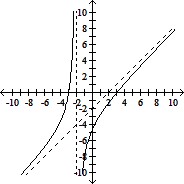Use the row transformation described to transform the matrix.

A. 
B. 
C. 
D. 
Answer: A
You might also like to view...
Find the area of the triangle. Approximate values to the nearest tenth when appropriate.Legs with lengths 9 ft and 9 ft
A.  ft2
ft2
B. 162 ft2
C. 18 ft
D. 81 ft2
Identify any vertical, horizontal, or oblique asymptotes in the graph of y = f(x). State the domain of f.
A. Vertical: x = -2; oblique: y = x + 2; (-?, 2) ? (2, ?) B. Vertical: x = -2; oblique: y = x + 2; (-?, -2) ? (-2, ?) C. Vertical: x = -2; oblique: y = x - 2; (-?, -2) ? (-2, ?) D. Vertical: x = 2; oblique: y = x - 2; (-?, 2) ? (2, ?)
Determine the x values that cause the function to be (a) zero, (b) undefined, (c) positive, and (d) negative.f(x) = 
A. (a)  , (b) {5} ? (-?, 3), (c) (3, 5), (d) (5, ?)
, (b) {5} ? (-?, 3), (c) (3, 5), (d) (5, ?)
B. (a) {3}, (b) {5} ? (-?, 3), (c) ?, (d) (3, 5) ? (5, ?)
C. (a)  , (b) {5} ? (-?, 3), (c) (3, 5) ? (5, ?), (d) ?
, (b) {5} ? (-?, 3), (c) (3, 5) ? (5, ?), (d) ?
D. (a) {3}, (b) {5} ? (-?, 3) , (c) (3, 5) ? (5, ?), (d) ?
Without graphing the function, state the shift(s) that are applied to the graph of  to graph the given function. If the graph of
to graph the given function. If the graph of  must be rotated about the x-axis, state this.f(x) = x2 + 2
must be rotated about the x-axis, state this.f(x) = x2 + 2
A. up 2 units B. left 2 units C. down 2 units D. right 2 units